Abstract
A crude Listeria cell wall fraction, a purified fraction (PF) with demonstrated biological activity, as well as a third fraction of base-hydrolyzed PF (BHPF) were analyzed for chemical composition and activities not previously described. Listeria cell wall fraction and PF contained significant quantities of lipid, whereas BHPF was lipid depleted. Fatty acid compositions were typical of gram-positive bacteria. PF and BHPF were depleted in protein. Alanine, glutamic acid, diaminopimelic acid, glucosamine, and muramic acid were found in all fractions, in enhanced concentration in PF and BHPF, and with molar ratios typical of bacterial peptidoglycans. Major neutral sugars were rhamnose, ribose, ribitol, and glucose. The concentrations of rhamnose, ribose, and glucose were increased in BHPF. Differences in chemical composition of the fractions reflected differences in their biological activities: Listeria cell wall fraction induced resistance to Listeria infection, whereas PF did not. Mitogenic and adjuvant activities were demonstrated for Listeria cell wall fraction and PF but were lost in BHPF. BHPF retained the ability to induce macrophage-mediated tumoricidal activity and decrease resistance to Listeria infection.
Full text
PDF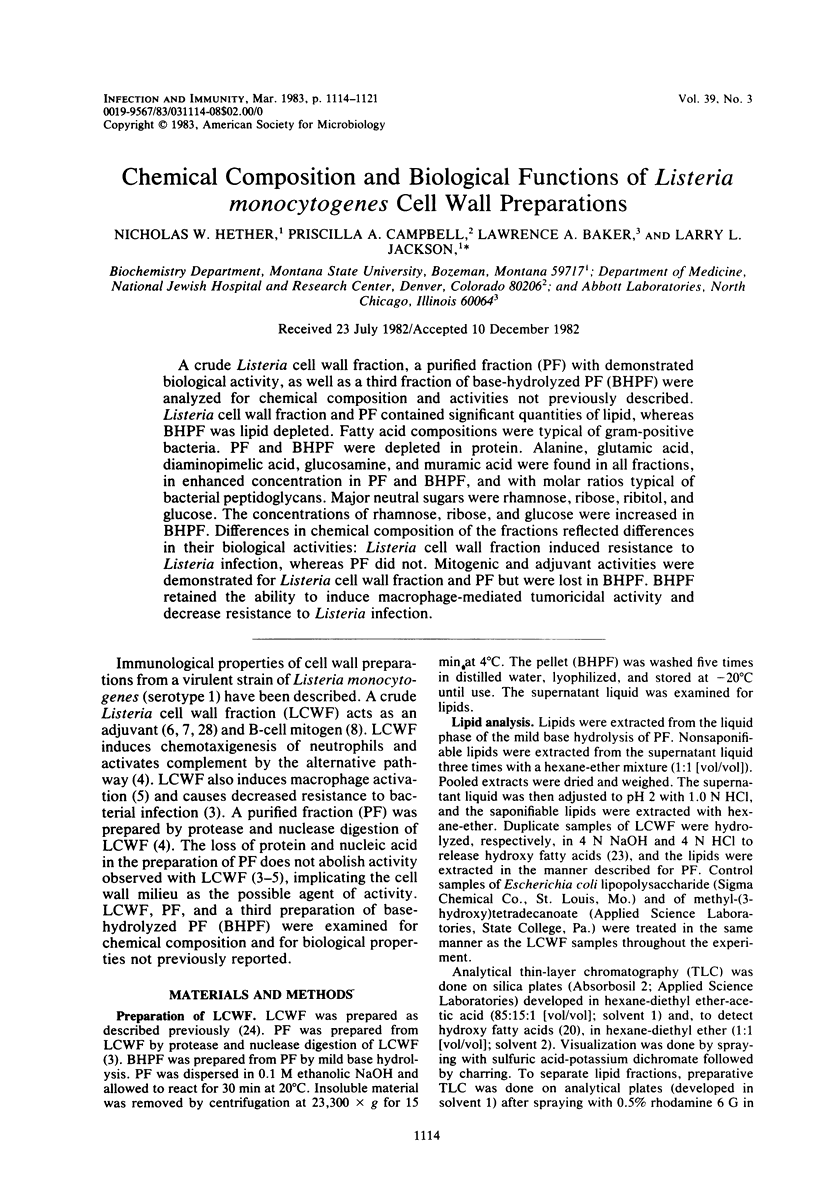
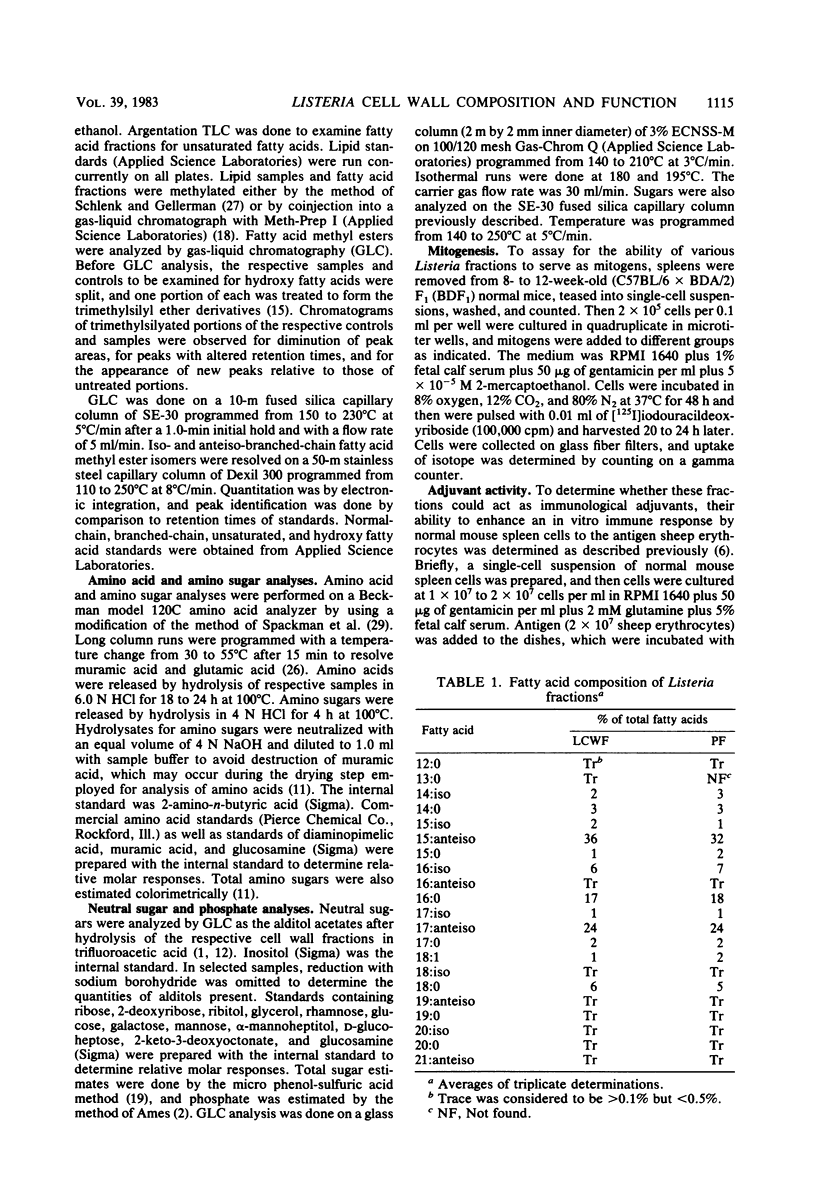
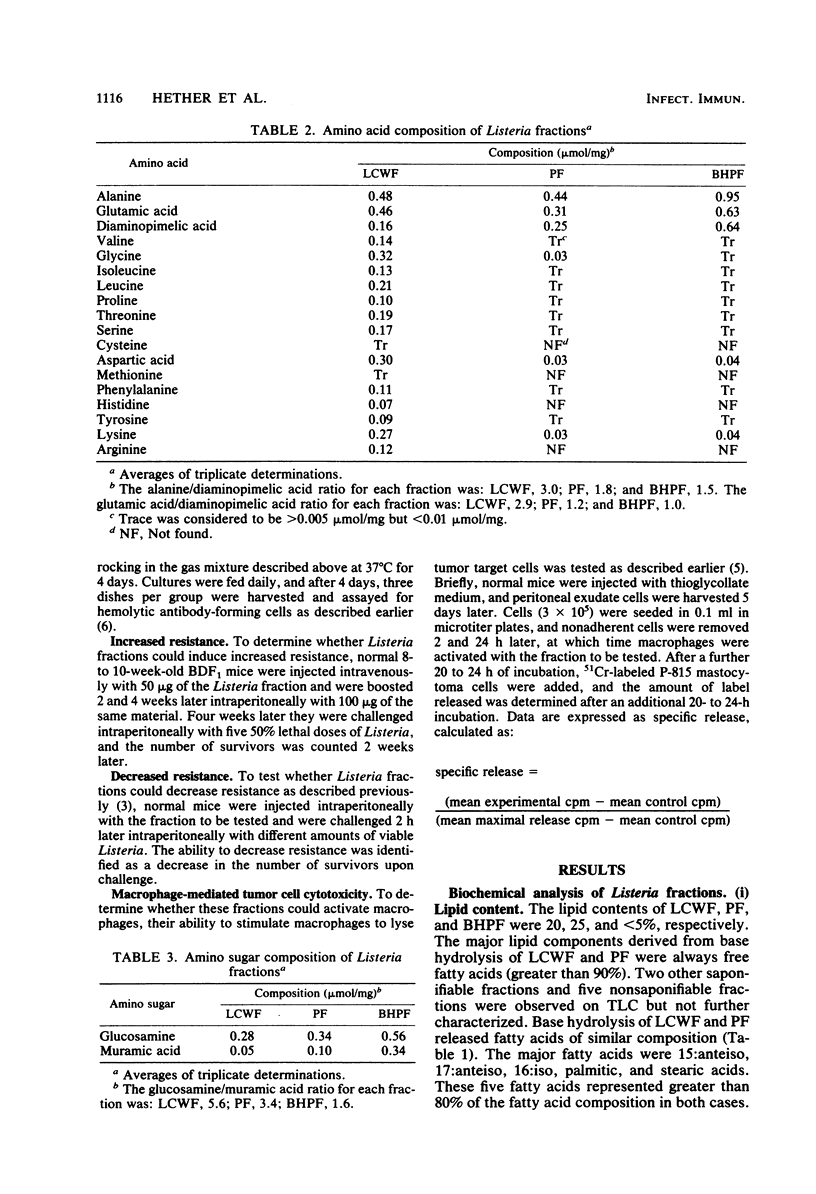
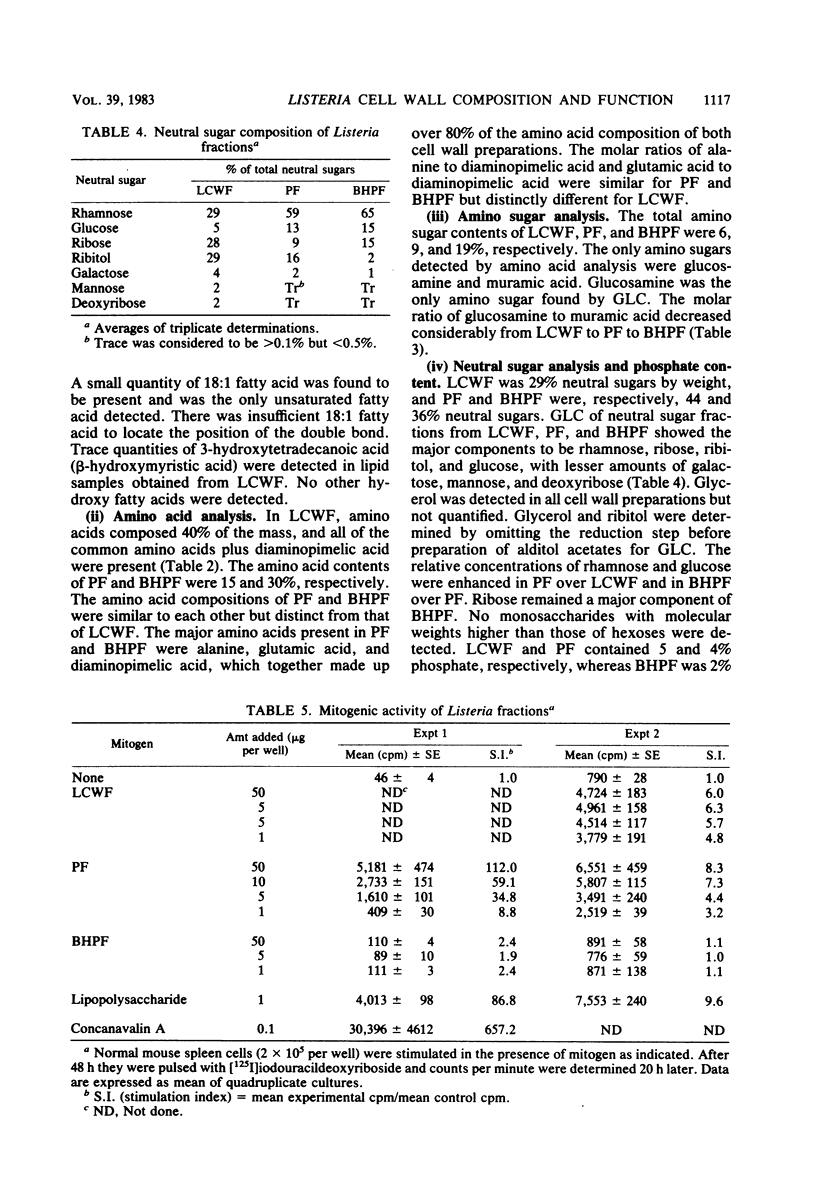
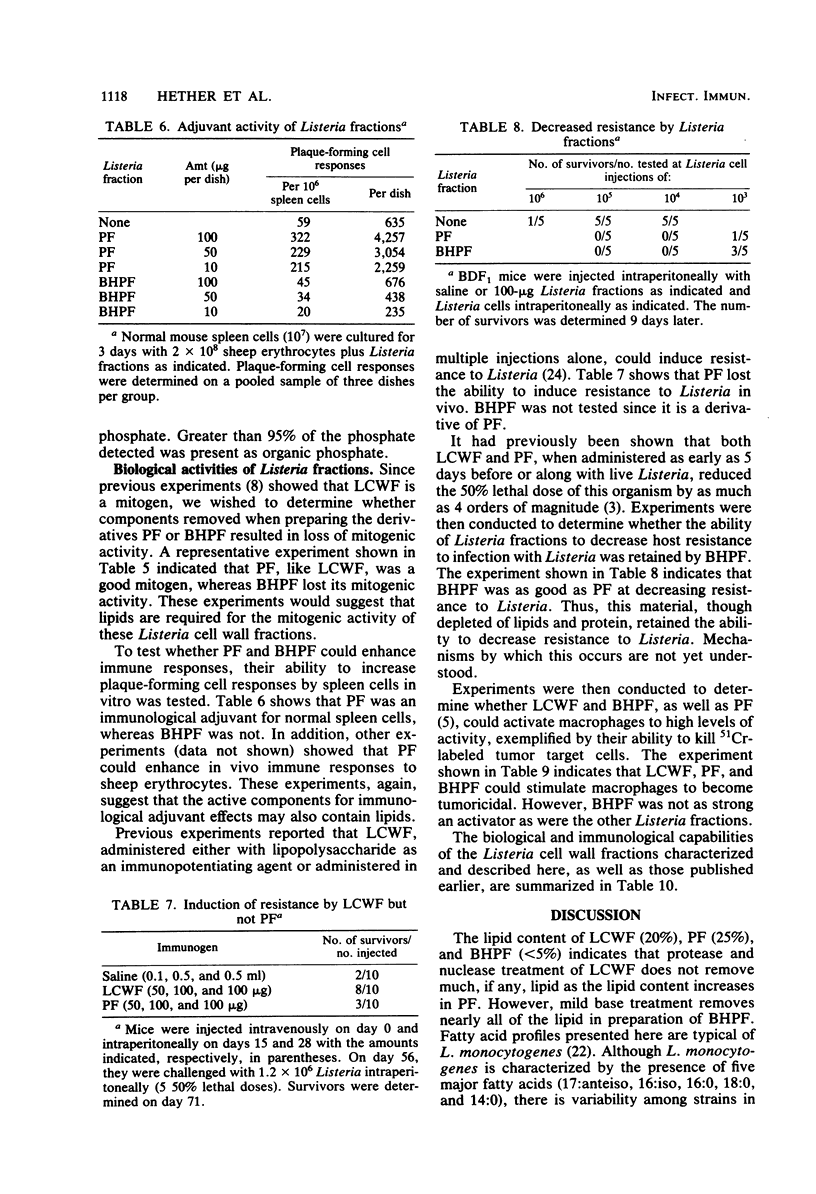
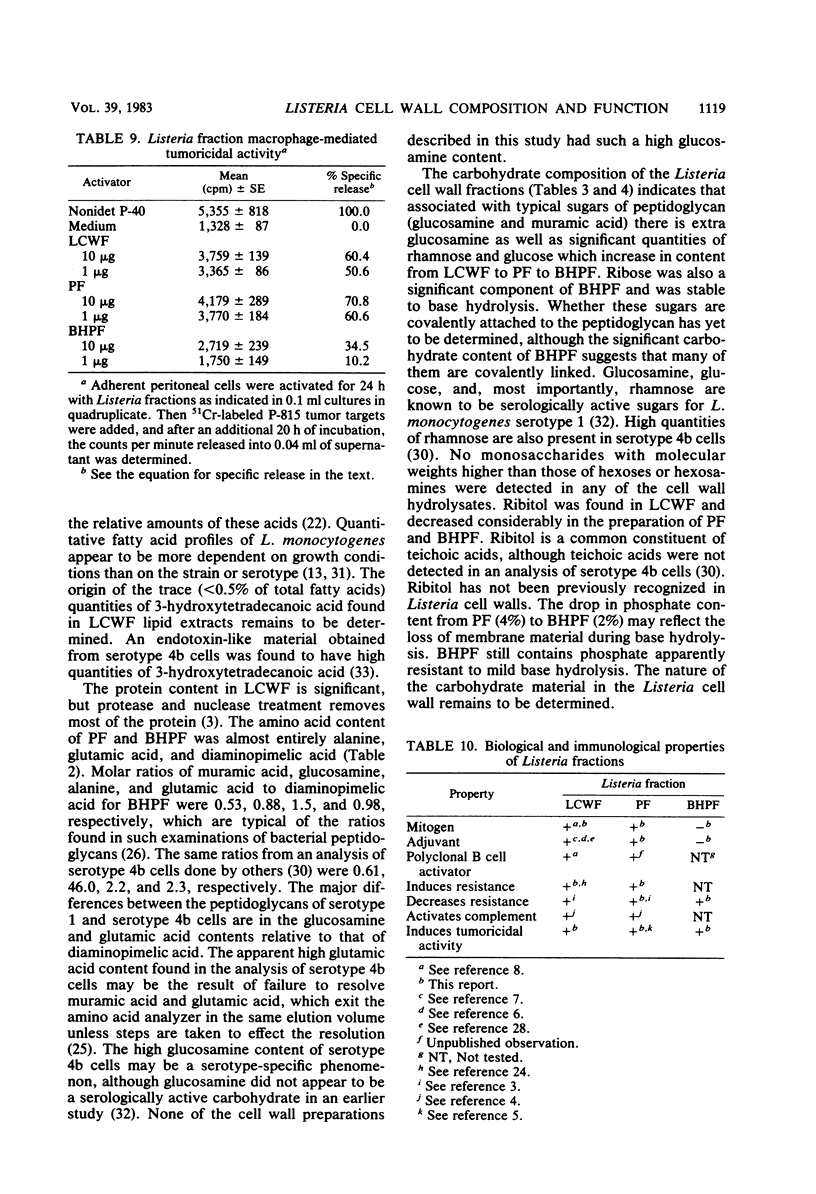
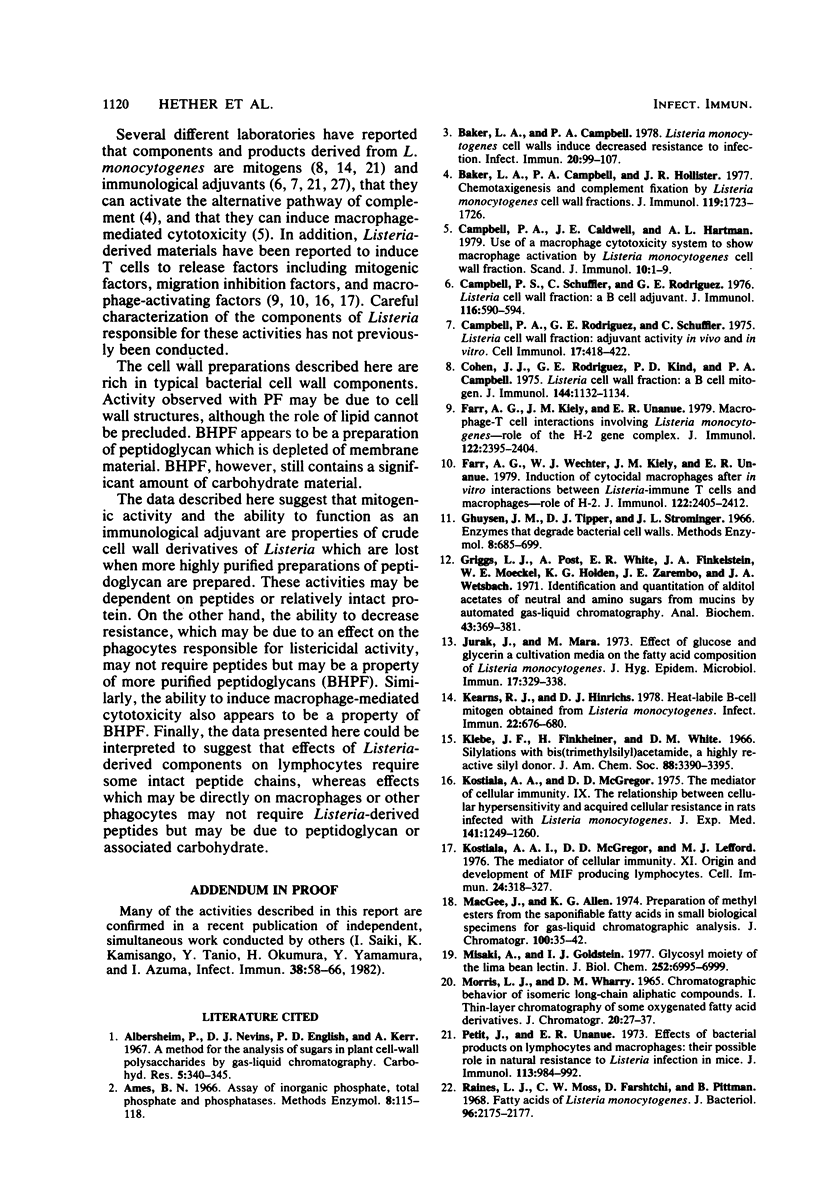
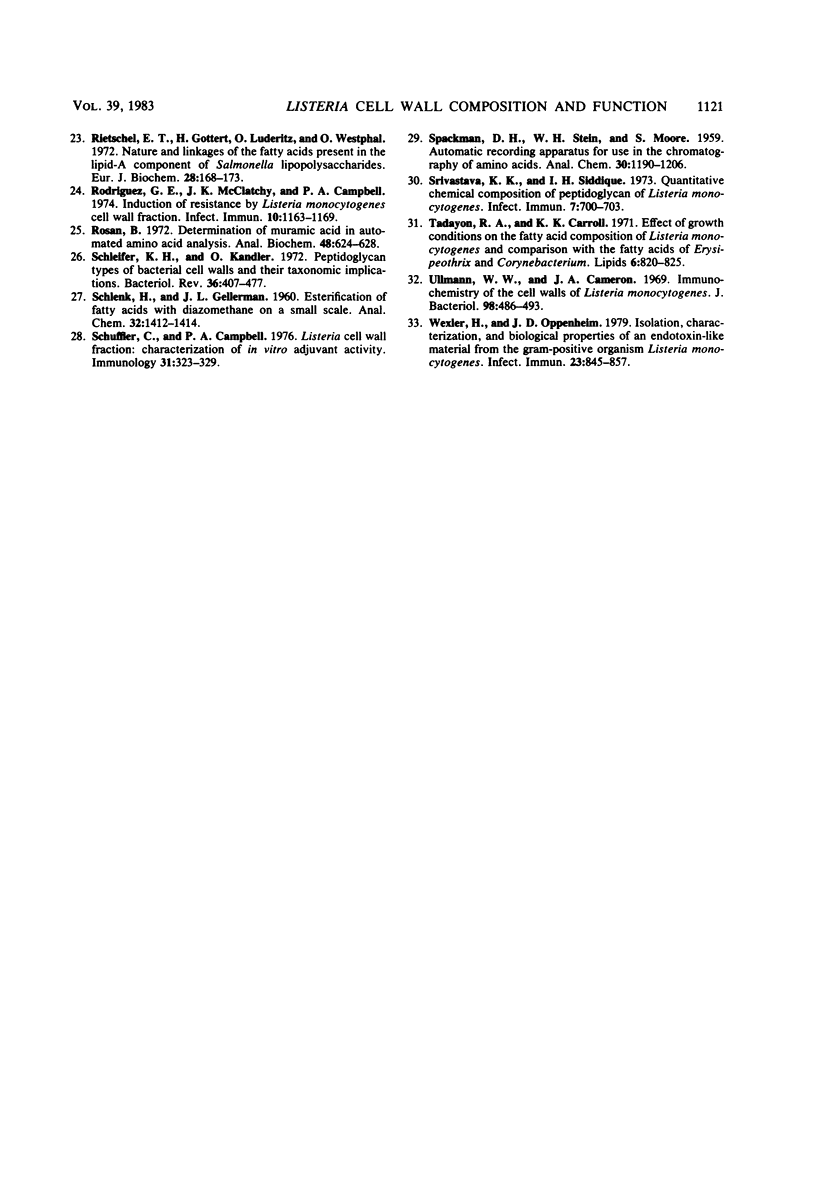
Selected References
These references are in PubMed. This may not be the complete list of references from this article.
- Baker L. A., Campbell P. A., Hollister J. R. Chemotaxigenesis and complement fixation by Listeria monocytogenes cell wall fractions. J Immunol. 1977 Nov;119(5):1723–1726. [PubMed] [Google Scholar]
- Baker L. A., Campbell P. A. Listeria monocytogenes cell walls induce decreased resistance to infection. Infect Immun. 1978 Apr;20(1):99–107. doi: 10.1128/iai.20.1.99-107.1978. [DOI] [PMC free article] [PubMed] [Google Scholar]
- Campbell P. A., Caldwell J. E., Hartman A. L. Use of a macrophage cytotoxicity system to show macrophage activation by Listeria monocytogenes cell wall fraction. Scand J Immunol. 1979;10(1):1–9. doi: 10.1111/j.1365-3083.1979.tb01327.x. [DOI] [PubMed] [Google Scholar]
- Campbell P. A., Rodriguez G. E., Schuffler C. Listeria cell wall fraction: adjuvant activity in vivo and in vitro. Cell Immunol. 1975 Jun;17(2):418–422. doi: 10.1016/s0008-8749(75)80045-1. [DOI] [PubMed] [Google Scholar]
- Campbell P. A., Schuffler C., Rodriguez G. E. Listeria cell wall fraction: a B cell adjuvant. J Immunol. 1976 Mar;116(3):590–594. [PubMed] [Google Scholar]
- Cohen J. J., Rodriguez G. E., Kind P. D., Campbell P. A. Listeria cell wall fraction: a B cell mitogen. J Immunol. 1975 Mar;114(3):1132–1134. [PubMed] [Google Scholar]
- Farr A. G., Kiely J. M., Unanue E. R. Macrophage-T cell interactions involving Listeria monocytogenes--role of the H-2 gene complex. J Immunol. 1979 Jun;122(6):2395–2404. [PubMed] [Google Scholar]
- Farr A. G., Wechter W. J., Kiely J. M., Unanue E. R. Induction of cytocidal macrophages after in vitro interactions between Listeria-immune T cells and macrophages--role of H-2. J Immunol. 1979 Jun;122(6):2405–2412. [PubMed] [Google Scholar]
- Griggs L. J., Post A., White E. R., Finkelstein J. A., Moeckel W. E., Holden K. G., Zarembo J. E., Weisbach J. A. Identification and quantitation of alditol acetates of neutral and amino sugars from mucins by automated gas-liquid chromatography. Anal Biochem. 1971 Oct;43(2):369–381. doi: 10.1016/0003-2697(71)90266-1. [DOI] [PubMed] [Google Scholar]
- Julák J., Mára M. Effect of glucose or glycerin in cultivation media on the fatty acid composition of Listeria monocytogenes. J Hyg Epidemiol Microbiol Immunol. 1973 Mar;17(3):329–338. [PubMed] [Google Scholar]
- Kearns R. J., Hinrichs D. J. Heat-labile B-cell mitogen obtained from Listeria monocytogenes. Infect Immun. 1978 Dec;22(3):676–680. doi: 10.1128/iai.22.3.676-680.1978. [DOI] [PMC free article] [PubMed] [Google Scholar]
- Kostiala A. A., McGregor D. D., Lefford M. J. The mediator of cellular immunity. XI. Origin and development of MIF producing lymphocytes. Cell Immunol. 1976 Jun 15;24(2):318–327. doi: 10.1016/0008-8749(76)90215-x. [DOI] [PubMed] [Google Scholar]
- Kostiala A. A., McGregor D. D. The mediator of cellular immunity. IX. The relationship between cellular hypersensitivity and acquired cellular resistance in rats infected with Listeria monocytogenes. J Exp Med. 1975 Jun 1;141(6):1249–1260. doi: 10.1084/jem.141.6.1249. [DOI] [PMC free article] [PubMed] [Google Scholar]
- MacGee J., Allen K. G. Preparation of methyl esters from the saponifiable fatty acids in small biological specimens for gas-liquid chromatographic analysis. J Chromatogr. 1974 Nov 13;100(1):35–42. doi: 10.1016/s0021-9673(00)86037-9. [DOI] [PubMed] [Google Scholar]
- Misaki A., Goldstein I. J. Glycosyl moiety of the lima bean lectin. J Biol Chem. 1977 Oct 25;252(20):6995–6999. [PubMed] [Google Scholar]
- Morris L. J., Wharry D. M. Chromatographic behaviour of isomeric long-chain aliphatic compounds. I. Thin-layer chromatography of some oxygenated fatty acid derivatives. J Chromatogr. 1965 Oct;20(1):27–37. doi: 10.1016/s0021-9673(01)97362-5. [DOI] [PubMed] [Google Scholar]
- Petit J. C., Unanue E. R. Effects of bacterial products on lymphocytes and macrophages: their possible role in natural resistance to listeria infetion in mice. J Immunol. 1974 Sep;113(3):984–992. [PubMed] [Google Scholar]
- Raines L. J., Moss C. W., Farshtchi D., Pittman B. Fatty acids of Listeria monocytogenes. J Bacteriol. 1968 Dec;96(6):2175–2177. doi: 10.1128/jb.96.6.2175-2177.1968. [DOI] [PMC free article] [PubMed] [Google Scholar]
- Rietschel E. T., Gottert H., Lüderitz O., Westphal O. Nature and linkages of the fatty acids present in the lipid-A component of Salmonella lipopolysaccharides. Eur J Biochem. 1972 Jul 13;28(2):166–173. doi: 10.1111/j.1432-1033.1972.tb01899.x. [DOI] [PubMed] [Google Scholar]
- Rodriguez G. E., McClatchy J. K., Campbell P. A. Induction of Resistance by Listeria monocytogenes Cell Wall Fraction. Infect Immun. 1974 Nov;10(5):1163–1169. doi: 10.1128/iai.10.5.1163-1169.1974. [DOI] [PMC free article] [PubMed] [Google Scholar]
- Rosan B. Determination of muramic acid in automated amino acid analysis. Anal Biochem. 1972 Aug;48(2):624–628. doi: 10.1016/0003-2697(72)90119-4. [DOI] [PubMed] [Google Scholar]
- Schleifer K. H., Kandler O. Peptidoglycan types of bacterial cell walls and their taxonomic implications. Bacteriol Rev. 1972 Dec;36(4):407–477. doi: 10.1128/br.36.4.407-477.1972. [DOI] [PMC free article] [PubMed] [Google Scholar]
- Schuffler C., Campbell P. A. Listeria cell wall fraction. Characterization of in vitro adjuvant activity. Immunology. 1976 Aug;31(2):323–329. [PMC free article] [PubMed] [Google Scholar]
- Srivastava K. K., Siddique I. H. Quantitative chemical composition of peptidoglycan of Listeria monocytogenes. Infect Immun. 1973 May;7(5):700–703. doi: 10.1128/iai.7.5.700-703.1973. [DOI] [PMC free article] [PubMed] [Google Scholar]
- Tadayon R. A., Carroll K. K. Effect of growth conditions on the fatty acid composition of Listeria monocytogenes and comparison with the fatty acids of Erysipelothrix and Corynebacterium. Lipids. 1971 Nov;6(11):820–825. doi: 10.1007/BF02531211. [DOI] [PubMed] [Google Scholar]
- Ullmann W. W., Cameron J. A. Immunochemistry of the cell walls of Listeria monocytogenes. J Bacteriol. 1969 May;98(2):486–493. doi: 10.1128/jb.98.2.486-493.1969. [DOI] [PMC free article] [PubMed] [Google Scholar]
- Wexler H., Oppenheim J. D. Isolation, characterization, and biological properties of an endotoxin-like material from the gram-positive organism Listeria monocytogenes. Infect Immun. 1979 Mar;23(3):845–857. doi: 10.1128/iai.23.3.845-857.1979. [DOI] [PMC free article] [PubMed] [Google Scholar]


